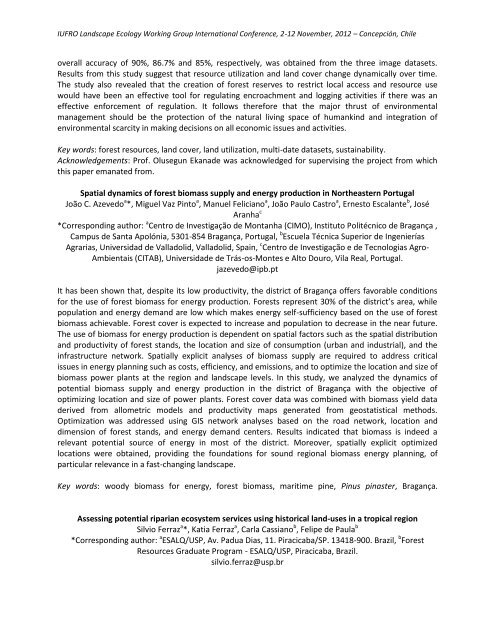BOOK OF ABSTRACTS - iufro landscape ecology conference
BOOK OF ABSTRACTS - iufro landscape ecology conference
BOOK OF ABSTRACTS - iufro landscape ecology conference
Create successful ePaper yourself
Turn your PDF publications into a flip-book with our unique Google optimized e-Paper software.
IUFRO Landscape Ecology Working Group International Conference, 2-12 November, 2012 – Concepción, Chileoverall accuracy of 90%, 86.7% and 85%, respectively, was obtained from the three image datasets.Results from this study suggest that resource utilization and land cover change dynamically over time.The study also revealed that the creation of forest reserves to restrict local access and resource usewould have been an effective tool for regulating encroachment and logging activities if there was aneffective enforcement of regulation. It follows therefore that the major thrust of environmentalmanagement should be the protection of the natural living space of humankind and integration ofenvironmental scarcity in making decisions on all economic issues and activities.Key words: forest resources, land cover, land utilization, multi-date datasets, sustainability.Acknowledgements: Prof. Olusegun Ekanade was acknowledged for supervising the project from whichthis paper emanated from.Spatial dynamics of forest biomass supply and energy production in Northeastern PortugalJoão C. Azevedo a *, Miguel Vaz Pinto a , Manuel Feliciano a , João Paulo Castro a , Ernesto Escalante b , JoséAranha c*Corresponding author: a Centro de Investigação de Montanha (CIMO), Instituto Politécnico de Bragança ,Campus de Santa Apolónia, 5301-854 Bragança, Portugal, b Escuela Técnica Superior de IngenieríasAgrarias, Universidad de Valladolid, Valladolid, Spain, c Centro de Investigação e de Tecnologias Agro-Ambientais (CITAB), Universidade de Trás-os-Montes e Alto Douro, Vila Real, Portugal.jazevedo@ipb.ptIt has been shown that, despite its low productivity, the district of Bragança offers favorable conditionsfor the use of forest biomass for energy production. Forests represent 30% of the district’s area, whilepopulation and energy demand are low which makes energy self-sufficiency based on the use of forestbiomass achievable. Forest cover is expected to increase and population to decrease in the near future.The use of biomass for energy production is dependent on spatial factors such as the spatial distributionand productivity of forest stands, the location and size of consumption (urban and industrial), and theinfrastructure network. Spatially explicit analyses of biomass supply are required to address criticalissues in energy planning such as costs, efficiency, and emissions, and to optimize the location and size ofbiomass power plants at the region and <strong>landscape</strong> levels. In this study, we analyzed the dynamics ofpotential biomass supply and energy production in the district of Bragança with the objective ofoptimizing location and size of power plants. Forest cover data was combined with biomass yield dataderived from allometric models and productivity maps generated from geostatistical methods.Optimization was addressed using GIS network analyses based on the road network, location anddimension of forest stands, and energy demand centers. Results indicated that biomass is indeed arelevant potential source of energy in most of the district. Moreover, spatially explicit optimizedlocations were obtained, providing the foundations for sound regional biomass energy planning, ofparticular relevance in a fast-changing <strong>landscape</strong>.Key words: woody biomass for energy, forest biomass, maritime pine, Pinus pinaster, Bragança.Assessing potential riparian ecosystem services using historical land-uses in a tropical regionSilvio Ferraz a *, Katia Ferraz a , Carla Cassiano b , Felipe de Paula b*Corresponding author: a ESALQ/USP, Av. Padua Dias, 11. Piracicaba/SP. 13418-900. Brazil, b ForestResources Graduate Program - ESALQ/USP, Piracicaba, Brazil.silvio.ferraz@usp.br


